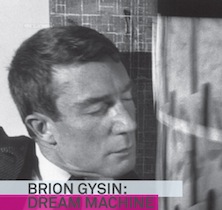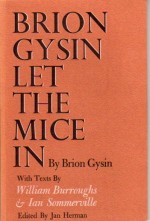“Brion Gysin: Dream Machine” opens today at the New Museum, in New York, and runs through Oct. 3. It is the first U.S. retrospective of Gysin’s work as painter, performer, poet, and writer. Here’s the museum’s spiel:

Which reminds me (again): Once upon a time, Brion Gysin let the mice in. That was way back in 1960. It became the title of a book published in 1973 by Something Else Press, which traced the origin of “cut-ups” as a technique applied to writing by Gysin and William Burroughs, a literary “method,” if you will, that gained notoriety following the publication of Burroughs’s partially cut-up “Naked Lunch.”Working simultaneously in a variety of mediums, Gysin was an irrepressible inventor, serial collaborator, and subversive spirit whose considerable innovations continue to influence musicians and writers, as well as visual and new media artists today. The exhibition will include over 300 drawings, books, paintings, photo-collages, films, slide projections, and sound works, as well as an original Dreamachine — a kinetic light sculpture that utilizes the flicker effect to induce visions when experienced with closed eyes. …
In 1959, Gysin created the Cut-Up Method, in which words and phrases were literally cut up into pieces and then rearranged to untether them from their received meanings and reveal new ones. His Cut-Up experiments, which he shared with his lifelong friend and collaborator William S. Burroughs, culminated in Burroughs and Gysin’s The Third Mind, a book-length collage manifesto on the Cut-Up Method and its uses. Transferring this notion to experimenting with tape-recorded poems manipulated by a computer algorithm, Gysin created sound poetry and was among the earliest users of the computer in art. At the same creative moment, Gysin conceived of the Dreamachine.
In an editor’s note to “Brion Gysin Let the Mice In,” I pointed out that their first cut-ups were published in “Minutes to Go” and “The Exterminator,” to which “Mice” was intended as a companion. I also noted that the title came via Gregory Corso. Gysin wrote me from Tangier:
The original text included the words “said Gregory Corso in 1960,” and they consequently appeared in the cut up text, also. Gregory disassociated himself from the whole idea so thoroughly that I agreed with Bill Levy of Insect Trust Gazette that he should be edited out and, now, I rather regret it but there was Gregory’s voice in there, squalling away to be let out of there, so we took the scissors to him.
“Those first cut-ups tested the potency of words. Further investigations tested the influence of other sensory input,” I wrote somewhat tendentiously. “Ian Sommerville and Brion Gysin designed a dream machine on which a patent was granted in 1961. William Burroughs explored a vast subject throughout the Sixties. He formulated, described, and applied to his literary work certain discoveries about Control — of consciousness and society — through sound & image. Certainly, it is difficult to think of any writer of fiction who paid so much attention to theorizing the discrete psychoactive suggestiveness of words.”
(Crossposted at HuffPo)


Dear Jan Herman,
Thank you for posting about this exhibition. A copy of your book is in the show. Will you happen to be in New York next week, July 13? The exhibition will host a reception and it would be great if you could come.
Thanks for your work on Gysin. It was a great help in our research.
Laura Hoptman
Kraus Family Senior Curator
New Museum